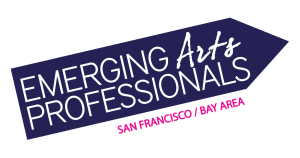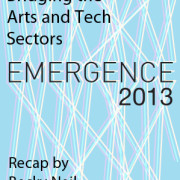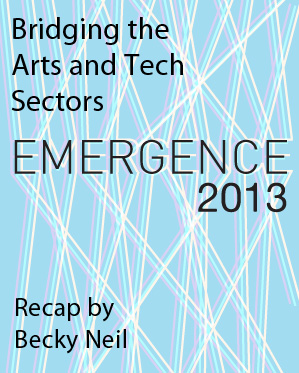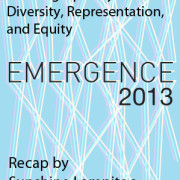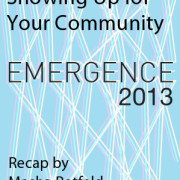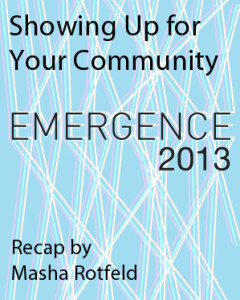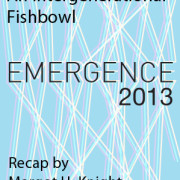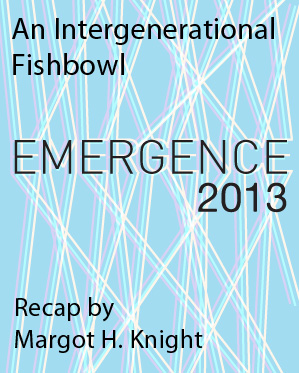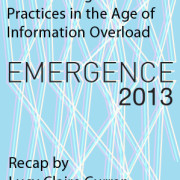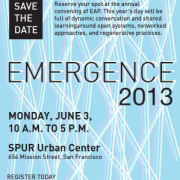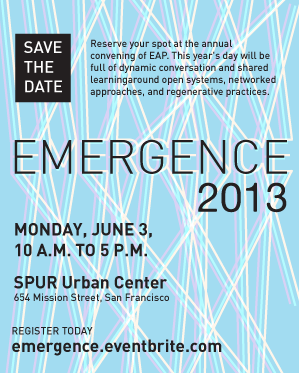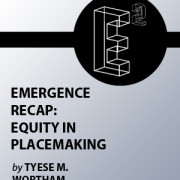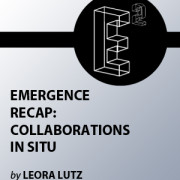Bridging the Arts and Tech Sectors
After a rousing and candid keynote panel on defining open systems, participants in the Emergence 2013 Networked Approaches track moved downstairs at SPUR for our first breakout session. Moderated by Maura Lafferty, independent PR consultant, this session’s topics focused on practical suggestions to improve collaboration between the arts and technology sectors. Maura gathered a balanced panel featuring Brianna Haag, marketing manager at Eventbrite; Emma Leggat, head of corporate social responsibility at StubHub; and Allison Murdock, organizer of Silicon Valley Rocks and VP of Marketing at GigaOM.
Maura began the conversation by asking the panelists to share how their organizations are currently involved in the arts, and it was both heartening and revealing to see how each company used the passions and interests of their employees to direct their efforts in the arts.
Emma shared how StubHub began their Rising Stars philanthropic program by identifying ways their employees and company assets were particularly well-suited to make a difference. Because StubHub is an event ticket resale platform, they discovered that music, youth development, and local organizations resonated particularly well with their employees.
As Emma put it, “Our employees are fans themselves!”Roots of Music, a New Orleans teen music program, was the perfect match to align with these interests, and received one of the initial Rising Stars grants in addition to leveraging the StubHub platform for their event ticketing.
The theme of shared values emerged as a key point of discussion as the conversation continued.
What values are shared between technology organizations and arts organizations? How can these shared values be leveraged to the mutual benefit of partner organizations?
Brianna urged arts administrators to think beyond funding when approaching a technology company, and consider the full spectrum of ways to partner and support mutual goals. She suggested in-kind sponsorship — such as free use of the company’s software — volunteer days, and workshops.
Allison agreed, saying, “You need to create opportunities to engage. Writing a check is nice, but create an opportunity to do something; an afternoon of engagement can lead to money later.”
Emma built on this, describing a holistic approach to working with tech companies: “Think of it as a funnel: a well-constructed program leads to volunteers leads to money.”
So put your brainstorm caps on, fellow arts managers, because these tech companies really want to hear innovative ways that they can build a lasting partnership with you!
If you are an arts organization looking to secure funding, sponsorship, or other support from a technology company, you may want to think about the following as you build your program:
-
Business strategy, marketing, and other expertise: Do you have an organizational challenge that the technology company’s employees may have the expertise to help with? Allison recommended that you think about ways they can advise you on improving processes, strategies, and plans.
-
Software, real estate, and other physical or digital assets: Does the technology company have a great location? Maybe you can use their grounds or conference room for a donor event. Do they have access to a wide channel of advertising? Maybe they can donate space for a week to your cause, like Emma did at StubHub for Roots of Music.
-
Opportunities to teach and learn: This goes both ways! In addition to sharing knowledge on specific computer tools, technology employees might want to learn to paint, dance, sing, or whatever skills and talents your organization offers. Brianna shared how excited her employees got when they were able to interact during a workshop with artists: they talked about it for months afterwards!
Of course, these relationships need to start somewhere.
Maura asked panelists, “What suggestions do you have for starting the conversation and initial outreach?” Here, it became clear through their anecdotes that startups look their employees for leadership.
Brianna explained how Eventbrite created an employee-led impact team that makes philanthropic decisions for the company on a quarterly basis. “So,” she said, “identify the people who are passionate [about your mission]. They will be your advocates from within the organization.”
To get past the email filter and initial blockade, “do your homework!” Allison urges. “You really have to research. Find those people and reach out to them directly.” Once you have an advocate on the inside, the word will get back around to the decision makers that this cause is important to their employees.
In all there is tremendous potential for cross-industry collaboration between technology and the arts. With this insider’s scoop in mind, arts professionals should be able to identify natural ways to align both organization’s missions and approach the right people to make those programs happen. I, for one, was pondering for days after of ways that I can get a tech expert to help me with my art project!
About Becky Neil
Becky Neil is a project lead at Bottlecap Gazebo, where she builds community through big art.
